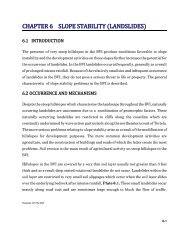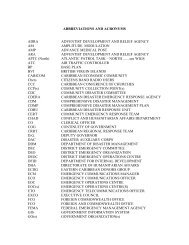Developers
Homeowners Handbook - The Department of Disaster Management
Homeowners Handbook - The Department of Disaster Management
- No tags were found...
You also want an ePaper? Increase the reach of your titles
YUMPU automatically turns print PDFs into web optimized ePapers that Google loves.
The grass and shallowness of the swalesreduces the velocity of the water and allowsfor infiltration and reduces erosion andtransportation of debris and sediments.Picture on left depicts a grassed swale.Grassed SwaleInfiltration trenches are filled with stones orloose aggregate which allow storm water toinfiltrate to underlying soil. These devicescan be used in conjunction with otherstormwater management features. Careshould be taken to avoid clogging up the fillmaterial with debris and sediment. Anillustration of an infiltration trench isprovided below.Cross-section of a Typical Infiltration Trench21Porous or permeable pavement contains voids that allow waterto pass though to underlying layers instead of running along thesurface as runoff. Pervious asphalt and concrete are suitablefor roadways, parking lots, sidewalks, driveways and walkways.Porous surfaces will require maintenance. The voids must bekept open in order for infiltration to occur. Periodic vacuumingmay be required to remove silt and debris. Porous pavementshould be installed in areas where erosion/sediment is minimal.Other products are available that are considered porous andcan be used to replace concreteand other impervious surfaces.Permeable pavers can be madefrom concrete or plastic and canbe filled with grass, sand orgravel.Porous Pavement










